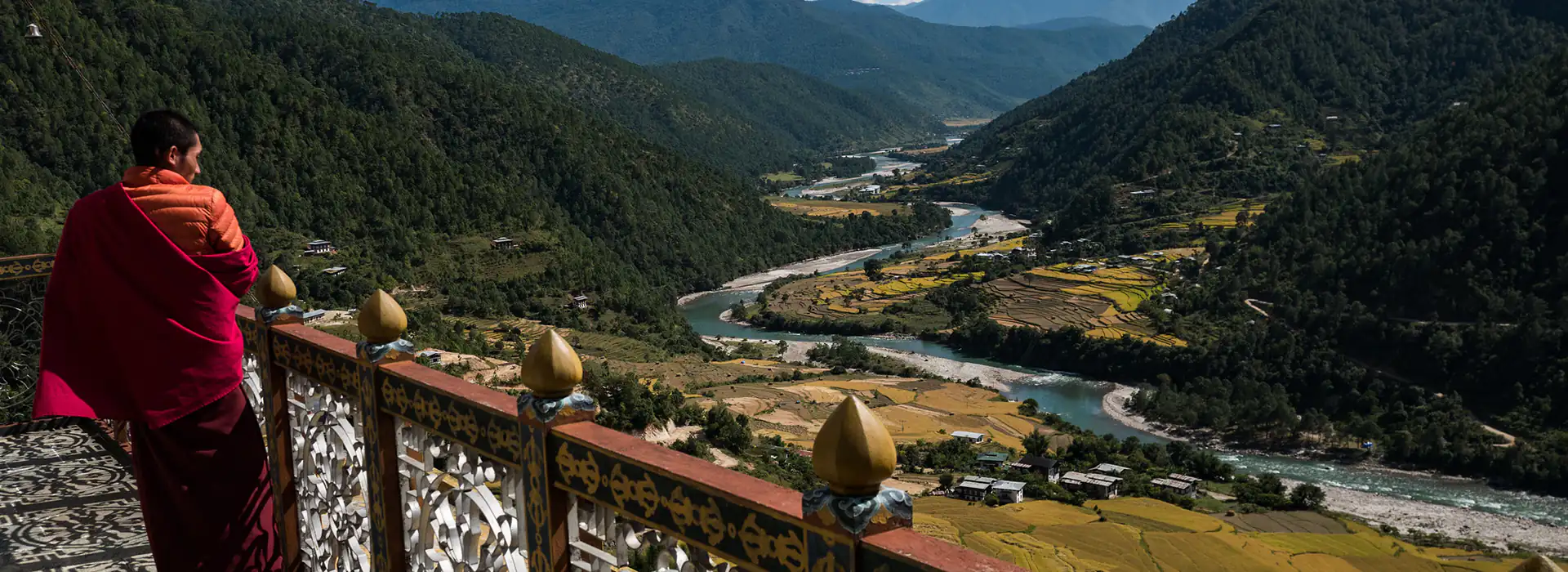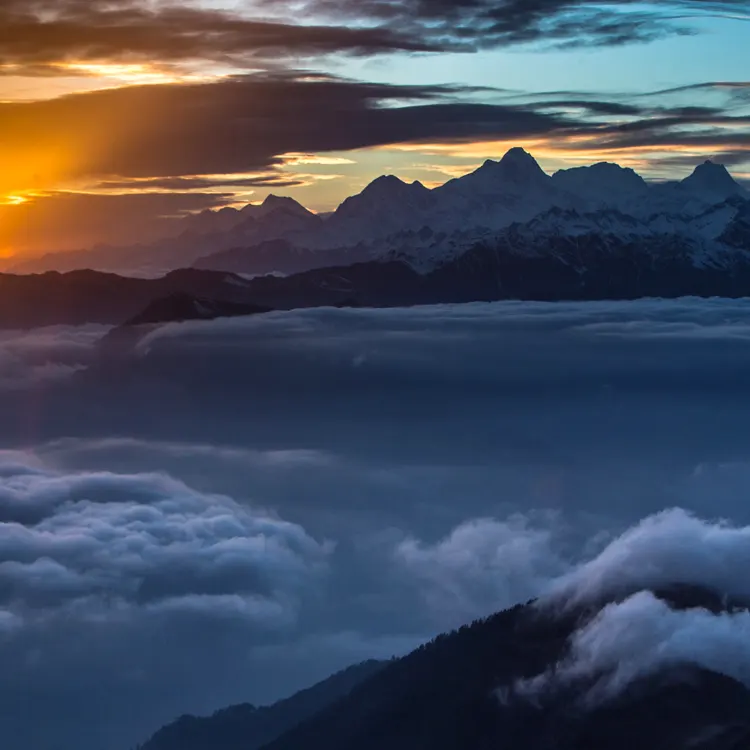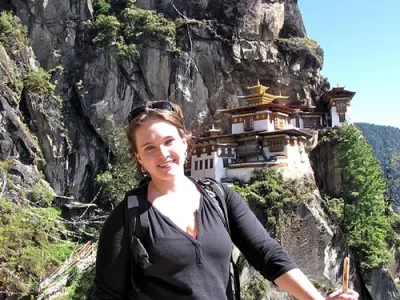Bhutan, a landlocked country with Tibet (China) in the North and India in the south, is located at the eastern end of the Himalayas and used to be the most isolated nation in the world. Bhutan is a mountainous country ranging from a little above sea level up to 7600m elevation of the high Himalayas with varying climatic conditions asserting from hot humid to alpine depending upon different altitudes and seasons. It is perhaps the last of Sangrilas, known as the Druk-Yul- the land of thunder Drag. The areas of Bhutan are similar to Switzerland, occupying only over 47000sq km with a little over 6000,000 population.
Bhutan consists of some breathtaking sceneries, is considered the best trekking destination in the world, and has a rich Buddhist culture. Trekking in Bhutan offers diverse climatic conditions with a natural wealth of flora and Fauna, magnificent mountains, scenic beauty, forest, crystalline air, self-sufficient and friendly people, terrific art and architecture, and a deep valley untouched by modernization which is a beautiful experience for any visitors who enjoys hiking and camping in rich natural habitat.
October, November, May, and March are the best seasons for Bhutan trekking for all the high-altitude treks going over 4000m. But some short treks like the Druk path trek, Bumthang cultural trek, and Gangtey natural trek can be undertaken anytime from October to May through the winter.
Bhutan Visa
Visa is a necessary constituent to travel to Bhutan. The Royal Government of Bhutan issues the visa after receiving full payment in advance. No other foreign mission or institutions are authorized to grant tourist visas. The visa costs the US $ 20.00 and could be extended by paying the additional US $ 15.00. A Visa fee has to be paid along with other payments. Visa applications must reach Bhutan before arrival, allowing enough time for processing. Visa is stamped on the passport on arrival at the Paro Airport. The two copies of original passport-size photos are essential o arrival, and the visa USD is for 14 days that can be extended with an additional fee of USD 15.
Traveling in Bhutan
All independent travel is prohibited in Bhutan, so every tourist (group and individual) must travel through a government company that must be pre-planned and prepared. The guided package tour or custom-designed work must be prepared on time.
Advance Payment
As the government issues visas only after receiving full tour payment, it is mandatory to make tour payments a month before the arrival date in Bhutan.
Druk Air (Royal Bhutan Airlines)
The Government of Bhutan has made it mandatory for all visitors to travel by Royal Bhutan Airlines (Druk Air). Only Druk Air is permitted into Paro Airport.
Glimpse of Bhutan
Location: Southern Asia, between China and India
Area: 47,000 sq km
Climate: Varieties; tropical in southern plains; cool winters and hot summers in central valleys; severe winters and cool summers in the Himalayas.
Terrain: mostly mountainous with some fertile valleys and savanna
Population: 1,951,965 (July 1999 est.)
Religions: Lamaistic Buddhism 75%, Indian- and Nepalese- influenced Hinduism 25%
Languages: Dzongkha (official), Bhotes speak various Tibetan dialects, Nepalese speak various Nepalese dialects
Capital: Thimpu
Places to visit in Bhutan
Thimpu
Thimpu, the capital city of Bhutan, is the main center for marketing agricultural goods produced in the surrounding valley and terraced hillside area, which includes rice, maize, and wheat. It lies on the River Raidek at an altitude of 2000m with 48,300 populations. As per the description of the history, we know the facts that the late King Jigme Dorje Wangchuck built the Thimpu and declared it the capital city of Bhutan, replacing the ancient capital of Punakha 30 years ago. Tashichhodzong, the Royal Government and Central Monastic Body seat is Thimpu’s most striking and magnificent visual landmark. Many institutions like the Royal school of performing arts, the school of traditional painting, the national textile museum, the Institute of Traditional medicine, etc., were established in Thimpu to provide information and insight into the Bhutanese cultures.
Thimpu is one of Asia’s two nation’s capitals with no traffic lights, but the country takes pride in its traffic police, which provides traffic signals with their dance-like movements of hands and arms.
Paro
The most attractive and unique valley in Bhutan, among many others, is Paro, which has historical importance as the center of two important trade routes in Tibet. It is 52km away from Thimpu and said that the houses in the Paro area are the most beautiful in the country. It is a small but eye-catching township with the only Bhutan airport serving tourists as the gateway to the Kingdom. The town is enclosed by many gorgeous surroundings and exciting places to visit. On the main street of Paro, you will probably get the best traditional architecture with decorated buildings and housing, restaurants, and many institutions. However, the most exciting place is Paro Dzong, the fortress monastery.
Furthermore, the picaresque place Dungste Lakhang is the other impressive site for visiting. On the Hill above the Dzong stands an ancient watchtower. The national museum of Bhutan 1967 has become a mysterious place that should visit once in life.
Punakha
Punakha is an ancient capital of Bhutan and the seat of Government till 1955; the capital is moved to Thimpu. Compared to Thimpu, it is pretty warm in winter and hot in the summer season, which is different from the climate of Thimpu. At a distance of 72 km lies Punakha city with an elevation of 1,200 m above sea level, which takes 3 hours to drive by car from the Capital city, Thimpu. This is a popular place as it was the home of Bhutan’s central Monastic body led by HH Je Khenpo.
The valley is a model rice-growing place in Western Bhutan as both red and white crops are grown along the river valley of Pho and Mo Chhu Rivers in the Punakha Wangdue valley. Till 1907, Punakha Dzong was the leading site of the coronation of Ugen Wangchuk (or Deb Nagpo), the first king of Bhutan.
Bumthang
With its unique geographical feature, Bhutan established itself as a distinctive region from all others. ‘Bhumthang’ is composed of ‘Bhum’ and ‘Thang,’ which is directly translated as “Beautiful Fields,” meaning field or flat place. Some say the name is also described as the valley of Beautiful girls. The vale is considered the religious center of Bhutan and has become the home of many oldest Buddhist temples. It is mainly famous for its festival Bumthang Tsechu, and the Paro and Thimpu Tsechu in Bhutan and Jambey Lhakang, Kurje Lakhang, Tamshing Lakhang, Jakar Dzong are some of the important places to see.
Wangdue Phodrang
Wangdue was the last town on the highway before entering central Bhutan, built in 1638. You can find well-provided shops and hotels in this town. There are three paved roads in Wangdue Phodrang dzongkhag. The Lateral Road enters from the west at Dochu La Pass, crosses the Pana Tsang Chhu at Wangdue Phodrang dzong, and continues east to Tongsa.



